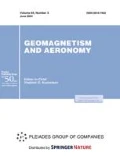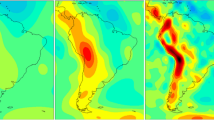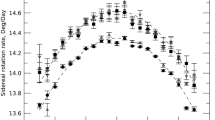Abstract
In this paper we analyze theoretically the effect of geomagnetic field on rotation of passive conductive satellites of a spherical shape such as Russian-Australian satellite WESTPAC or Russian satellite Larets. The main cause of this effect is the generation of eddy currents and satellite magnetic moment, which interact with the Earth’s magnetic field. The analytical solutions have been derived for orbital and intrinsic magnetic moments of satellite, which result from a translatory motion of an Earth-orbiting satellite and from a satellite spin around axes passing through its center of mass. An arbitrary relation between skin layer depth and satellite radius is assumed. Both a torque acting on satellite in geomagnetic field and the changes in its angular velocity are derived. The satellite orbiting the Earth in a circular orbit with an arbitrary tilt of the orbital plane is studied having regard to rotation of the vector of geomagnetic dipole moment. A characteristic time it takes for the angular velocity of the satellite to decrease exponentially is estimated. Peculiarities of residual irregular vibrations of the satellite angular velocity are examined.





Similar content being viewed by others
REFERENCES
Ablyazov, M.K., Surkov, V.V., and Chernov, A.S., Distortion of an external magnetic field by an expanding plasma sphere located in a slightly conductive semispace, J. Appl. Mech. Tech. Phys., 1988, vol. 29, no. 6, pp. 778–784.
Beletsky, V.V., Dvizhenie iskusstvennogo sputnika otnositel’no tsentra mass (Motion of an Artificial Satellite about Its Center of Mass), Moscow: Nauka, 1965; Jerusalem: Israel program for scientific translation, 1966.
Candini, G.P., Piergentili, F., and Santoni, F., Miniaturized attitude control system for nanosatellites, Acta Astronaut., 2012, vol. 81, no. 1, pp. 325–334.
Guo, J., Bouwmeester, J., and Gill, E., In-orbit results of Delfi-n3Xt: Lessons learned and move forward, Acta Astronaut., 2016, vol. 121, pp. 39–50.
Ivanov, D., Ovchinnikov, M., Penkov, V., Roldugin, D., Doronin, D., and Ovchinnikov, A., Advanced numerical study of the three-axis magnetic attitude control and determination with uncertainties, Acta Astronaut., 2017, vol. 132, pp. 103–110.
Kucharski, D., Kirchner, G., Lim, H.-C., and Koidl, F., New results on spin determination of nanosatellite BLITS from High Repetition Rate SLR data, Adv. Space Res., 2013, vol. 51, no. 5, pp. 912–916. https://doi.org/10.1016/j.asr.2012.10.008
Landau, L.D. and Lifshits, E.M., Teoreticheskaya fizika (Theoretical Physics), vol. 2: Teoriya polya (Theory of Fields), Moscow: Fizmatlit, 1960; New York: Pergamon, 1971.
Landau, L.D. and Lifshits, E.M., Teoreticheskaya fizika (Theoretical Physics), vol. 8: Elektrodinamika sploshnykh sred (Electrodynamics of Continuous Media), Moscow: Fizmatlit, 1982; New York: Pergamon, 1960.
Müncheberg, S., Krischke, M., and Lemke, N.M.K., Nanosatellites and micro systems technology—capabilities, limitations and applications, Acta Astronaut., 1966, vol. 39, nos. 9–12, pp. 799–808. https://doi.org/10.1016/S0094-5765(97)00063-5
Ovchinnikov, M.Yu., Roldugin, D.S., Tkachev, S.S., Study of the accuracy of active magnetic damping algorithm, Preprint of Keldysh Institute of Applied Mathematics, Russ. Acad. Sci., Moscow, 2016, no. 133. https://doi.org/10.20948/prepr-2016-133-e
Ovchinnikov, M.Yu., Penkov, V.I., Roldugin, D.S., and Pichuzhkina, A.V., Geomagnetic field models for satellite angular motion studies, Acta Astronaut., 2018, vol. 144, pp. 171–180.
Petrukovich, A.A. and Nikiforov, O., Small satellites for scientific research, Rocket-Space Dev.Eng. Inf. Syst., 2016, vol. 3, no. 4, pp. 22–31. https://doi.org/10.17238/issn2409-0239.2016.4.22
Pichuzhkina, A.V. and Roldugin, D.S., Geomagnetic field models for satellite angular motion Preprint of Keldysh Institute of Applied Mathematics, Russ. Acad. Sci., Moscow, 2016, no. 87. https://doi.org/10.20948/prepr-2016-87-e
Rosenstock, H.B., The effect of the Earth’s magnetic field on the spin of the satellite, Astronaut. Acta, 1957, vol. 3, no. 3, pp. 215–226.
Rubis A. Larets and BLITS are nanosatellites of GLONASS, Vozdushno-Kos. Sfera, 2016, nos. 3–4, pp. 88–89.
Sadov, Yu.A., Periodic motion of a satellite with a magnetic damper in the plane of a circular orbit, Cosmic Res., 1969, vol. 7, no. 1, pp. 51–60.
Samotokin, B., Shostachuk, D., Korobiichuka, I., Kachniarzb, M., and Nowicki, M., The satellites orientation method using a torque magnetic drive, Acta Phys. Pol. A, 2018, vol. 133, no. 3, pp. 722–724. https://doi.org/10.12693/APhysPolA.133.722
Santoni, F. and Zelli, M., Passive magnetic attitude stabilization of the UNISAT-4 microsatellite, Acta Astronaut., 2009, vol. 65, nos. 5–6, pp. 792–803.
Surkov, V.V., and Mozgov, K.S., Effects of the action of particle fluxes and geomagnetic variations on low-orbital spherical satellites, Cosmic Res., 2019, vol. 57, no. 4, pp. 252–260. https://doi.org/10.1134/S0010952519040075
Vasiliev, V.P., Shargorodsky, V.D., Novikov, S.B., Chubykin, A.A., Parkhomenko, N.N., Sadovnikov, M.A., Progress in laser systems for precision ranging, angle measurements, photometry, and data transfer, in International Laser Ranging Service (ILRS) Fall 2007 Workshop, Grasse, France, 2007.
Vasil’ev, V.P., A way to precision, Ross. Kosmos, 2018, vol. 2, no. 145, pp. 10–14. 2018.
Zonov, Yu.V., On the question of interaction between satellite and the Earth magnetic field, in Iskusstvennye sputniki Zemli (Artificial Satellites of the Earth), AN SSSR, 1959, no. 3, pp. 118–124.
ACKNOWLEDGMENTS
The author would like to thank Dr. Vladimir P. Vasiliev and Dr. Konstantin S. Mozgov for helpful discussions of the results of this study.
Author information
Authors and Affiliations
Corresponding author
Ethics declarations
This research was partly supported by RFBR, grant no. 18-05-00108.
Additional information
Translated by V. V. Surkov
Appendices
APPENDIX 1
The problem under consideration has axial symmetry due to homogeneity of the vector field \({{\partial }_{t}}{{{\mathbf{B}}}_{e}} = {{\dot {B}}_{{ez}}}{\mathbf{\hat {z}}}{\text{.}}\) Here the dot over the symbol denotes the derivative with respect to time. Whence it follows that all the functions depend on variables \(r{\text{,}}\)\(\theta \) and \(t\) but are independent of azimuthal angle. In such a case it is suitable to seek for the solution of equation (2) for geomagnetic field perturbations in the form (r < a):
where \({\mathbf{\hat {r}}}\) and \({\mathbf{\hat {\theta }}}\) are the unit vectors while \({{b}_{r}}\left( {r,t} \right)\) and \({{b}_{\theta }}\left( {r,t} \right)\) are unknown functions. Substituting equation (A1.1) for \({{{\mathbf{b}}}_{2}}\) into vector equation (2), taking into account that \({{\partial }_{t}}{{{\mathbf{B}}}_{e}} = {{\dot {B}}_{{ez}}}\left( {{\mathbf{\hat {r}}}\cos \theta - {\mathbf{\hat {\theta }}}\sin \theta } \right)\) and rearranging, we are thus left with the set:
Equation \(\nabla \cdot {\mathbf{b}} = {\mathbf{0}}\) takes form:
In order to solve the set of equations (A1.2)–(A1.4) we apply a technique used by Ablyazov et al (1988). To do this let us introduce the new unknown functions: \(f = {{b}_{r}} - {{b}_{\theta }}\) and \(g = {{b}_{r}} + 2{{b}_{\theta }}{\text{.}}\) Rearranging equations (A1.2)–(A1.4) we arrive at
In order to disregard the ball magnetization in the geomagnetic field, the magnetic permeability of the ball is assumed to be unity. From the requirement of the magnetic field continuity at the ball surface it follows that \({{{\mathbf{b}}}_{1}}\left( {a,t} \right) = {{{\mathbf{b}}}_{2}}\left( {a,t} \right){\text{.}}\) Substituting equations (3) and (A1.1) for \({{{\mathbf{b}}}_{1}}\) and \({{{\mathbf{b}}}_{2}}\) into the above relationship, we come to the following boundary conditions
In the absence of any perturbations at the initial time, the initial conditions of the problem are as follows \(g\left( {r,0} \right) = f\left( {r,0} \right) = 0.\) The proof of the fact that the set of equations (A1.5)–(A1.7) under the above boundary and initial conditions has a unique solution can be found in (Ablyazov et al., 1988).
The solution of equation (A1.5), which is bounded at \(r = 0\) and subjected to the boundary condition (A1.8), can be expressed in a power series of the functions \(\sin \left( {{{\pi nr} \mathord{\left/ {\vphantom {{\pi nr} a}} \right. \kern-0em} a}} \right)\) constituting a full set of the orthonormal basis functions for our boundary-value problem:
where \({{\gamma }_{n}}\left( t \right)\) are unknown functions. In a similar fashion we can expend the function \({{\dot {B}}_{{ez}}}\) in a power series of the same basis functions despite \({{\dot {B}}_{{ez}}}\) is independent of \(r{\text{.}}\) Substituting this power series and equation (A1.9) into equation (A1.5) yields
The solution of equation (A1.10) under zero initial conditions is given by
Here we have taken into account that \({{\dot {B}}_{{ez}}}\) is not a constant but, generally speaking, a slowly varying function of time. Substituting equation (A1.11) for \({{\gamma }_{n}}\) into equation (A1.9), we obtain the function \(g\left( {r,t} \right){\text{.}}\) In order to find other unknown function \(f\left( {r,t} \right)\) we use equation (A1.7), whence it follows that
Substituting equation (A1.12) for \(f\left( {a,t} \right)\) into the boundary conditions (A1.8), we come to equation (4) for the effective magnetic moment of the ball.
APPENDIX 2
For the sake of convenience, the derivative in time will be further denoted by a point. From equations (8) and (9) it then follows that the magnetic field components in the coordinate system fixed to the satellite orbit plane have the form:
where \({{\varphi }_{e}} = {{\varphi }_{e}}\left( t \right)\) and the functions \({{x}_{m}}\left( t \right){\text{,}}\)\({{y}_{m}}\left( t \right)\) and \({{z}_{m}}\left( t \right)\) are given by equation (11). The time derivatives of equations (A2.1) are given by:
where
Substituting equations (A2.1)–(A2.3) into equation (10), we obtain the torque of Ampere force.
Rights and permissions
About this article
Cite this article
Surkov, V.V. Effect of Geomagnetic Field on Motion of Passive Conductive Satellites. Geomagn. Aeron. 60, 192–204 (2020). https://doi.org/10.1134/S0016793220020152
Received:
Revised:
Accepted:
Published:
Issue Date:
DOI: https://doi.org/10.1134/S0016793220020152




